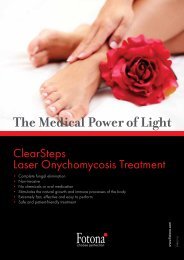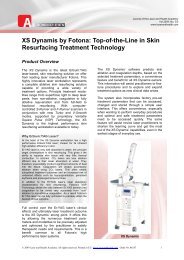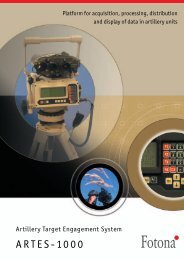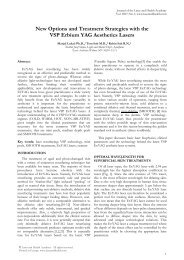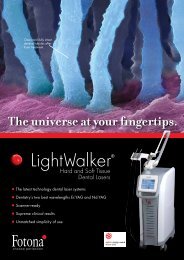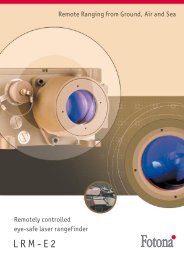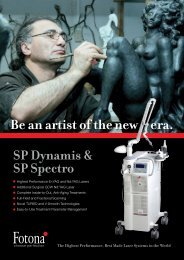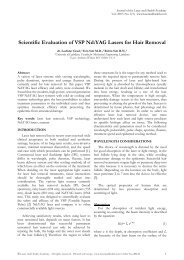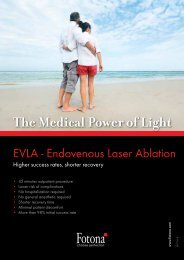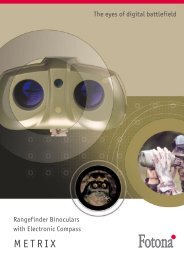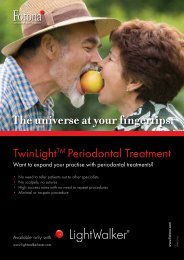Pixel Screen Technology and FRAC3 – A Full Spectrum of ... - Fotona
Pixel Screen Technology and FRAC3 – A Full Spectrum of ... - Fotona
Pixel Screen Technology and FRAC3 – A Full Spectrum of ... - Fotona
- No tags were found...
Create successful ePaper yourself
Turn your PDF publications into a flip-book with our unique Google optimized e-Paper software.
Journal <strong>of</strong> the Laser <strong>and</strong> Health AcademyVol. 2008; No.1/1; www.laser<strong>and</strong>health.com<strong>Pixel</strong> <strong>Screen</strong> <strong>Technology</strong> <strong>and</strong> <strong>FRAC3</strong> <strong>–</strong> A <strong>Full</strong> <strong>Spectrum</strong> <strong>of</strong> LaserSkin Rejuvenation TreatmentsMartin Gorjan 1 , Ladislav Grad 1 , Matjaž Lukač 21University <strong>of</strong> Ljubljana, Slovenia2Institute Josef Stefan, Ljubljana, SloveniaINTRODUCTIONFractional laser skin rejuvenation has recently gained a lot<strong>of</strong> interest due to the fact that the remaining healthytissue around the fractional damage spots can act ashealing centers. The approach, to date, has been formingthe fractional pattern as a two-dimensional matrix;resulting in the illuminated columns below the spotsbeing damaged uniformly (see Fig.1 b). For ablative <strong>and</strong>skin-surface treatments this approach is very effective asit allows a ‘lighter’ variant <strong>of</strong> the traditional ablativeprocedure to be completed, with a lower density effect<strong>and</strong> faster recovery times. However, for non-ablative,deeper, skin-volume treatments this technique is nonselectivewith regard to local skin imperfections, <strong>and</strong> istherefore less suited for these particular procedures.For this reason <strong>Fotona</strong> is also pioneering the novel<strong>FRAC3</strong> laser treatment, based on their Nd:YAG Accelerapulse mode characteristics. The method produces a threedimensional,fractional pattern within the epidermis <strong>and</strong>dermis, with damage isl<strong>and</strong>s located predominantly at thesites <strong>of</strong> minute skin imperfections <strong>and</strong>/orinhomogeneities (See Fig.1c). This self-inducedfractionality has been found to be especially pronouncedin skin with a higher number <strong>of</strong> aging imperfections.FRACTIONAL TREATMENTS USING PIXELSCREEN TECHNOLOGY<strong>Fotona</strong> Er:YAG lasers have always <strong>of</strong>fered a range <strong>of</strong>rejuvenation treatments with the ability to use <strong>Fotona</strong>’sVariable Square Pulse technology to control the balancebetween ablation <strong>and</strong> thermal effects on the treatedtissue. The spectrum <strong>of</strong> treatments possible ranges frompure cold ablation, through a balance <strong>of</strong> ablative <strong>and</strong>thermal effects, to solely thermal effects [1]. The <strong>Pixel</strong><strong>Screen</strong> <strong>Technology</strong> (PST) works in conjunction with<strong>Fotona</strong>’s highly-effective Er:YAG lasers. The <strong>Pixel</strong><strong>Screen</strong> distributes the energy as an array <strong>of</strong> small pointbeams generating, very finely-focused, high-intensitytreatment columns.The treatment effect <strong>of</strong> the PST is to add a further level<strong>of</strong> control to the procedures above, with a smallerproportion <strong>of</strong> the skin surface being treated, <strong>and</strong> with thecapability to fine-tune this further through the variation<strong>of</strong> the pixel density used. This less-invasive treatmentmodality significantly reduces downtime after theprocedure.Fig. 2: The laser intensity pr<strong>of</strong>ile for a st<strong>and</strong>ard Er:YAGlaser beam (dotted line) <strong>and</strong> with <strong>Pixel</strong> <strong>Screen</strong> <strong>Technology</strong>(continuous line).NOVEL THREE DIMENSIONAL FRACTIONALTREATMENTSWhile the action <strong>of</strong> more-conventional fractionaltechniques, such as those provided by the <strong>Fotona</strong> <strong>Pixel</strong><strong>Screen</strong>, are well-known <strong>and</strong> have now been proven over anumber <strong>of</strong> years, the novel <strong>FRAC3</strong> treatment beingpioneered by <strong>Fotona</strong> is not so widely known. <strong>Fotona</strong>utilize a special operating mode, Accelera, developed toenable short, sub-2ms pulses in their renowned highperformanceNd:YAG laser systems, to create selfselectivetreatment micro-zones within the skin [2]. Thelaser energy acts only on the minute skin imperfectionswithin the skin volume, thus reducing the collateraldamage <strong>and</strong> only creating localized ‘damage isl<strong>and</strong>s’. Withthis selective, very-localized <strong>and</strong> three-dimensionaldistribution <strong>of</strong> the treatment effects, ‘damage isl<strong>and</strong>s’ aresurrounded by unharmed healthy tissue which can thenpromote the speedy healing <strong>of</strong> the treated tissue.© 2008 Laser <strong>and</strong> Health Academy. All rights reserved. Printed in Europe. www.laser<strong>and</strong>health.com
<strong>Pixel</strong> <strong>Screen</strong> <strong>Technology</strong> <strong>and</strong> <strong>FRAC3</strong> Treatmentsleading to better cost-effectiveness for the skinrejuvenation procedure as well.Fig. 1Laser induced damage isl<strong>and</strong>s as healing centers.Skin surface measurements <strong>of</strong> the temperaturedistribution following treatment with an Nd:YAG laser inAccelera mode were performed in-vivo on patients’h<strong>and</strong>s. Figure 3a shows a typical skin temperature pr<strong>of</strong>ilefollowing a st<strong>and</strong>ard 20 msec long Nd:YAG pulse, whileFig.3b shows the temperature pr<strong>of</strong>ile following a shortdurationAccelera pulse. Self-induced temperaturefractionality can only be observed following illuminationwith the Accelera pulses, while with st<strong>and</strong>ard pulsedurations heat conduction from the skin inhomogeneitiesto the surrounding tissue prevents temperature build-up,<strong>and</strong> thus no hot isl<strong>and</strong>s are observed within the skin [2].Note, that the ‘temperature isl<strong>and</strong>s’ observed here werefound to be more prevalent in older patients than inyounger ones, meaning that this treatment modality isparticularly effective within anti-aging therapies.One feature <strong>of</strong> this treatment modality is its requirementfor relatively high energy <strong>and</strong> fluences at short pulsedurations, meaning it is difficult to achieve with largerspot sizes. Thus, for larger area coverage <strong>and</strong> ease <strong>and</strong>speed <strong>of</strong> treatment, a scanner is the ideal beam deliverymethod. The <strong>Fotona</strong> S-11 scanner enables <strong>FRAC3</strong>treatments to be quickly <strong>and</strong> easily carried out withoptimal spot sizes, <strong>and</strong> an adjustable scan area <strong>of</strong> up to 42cm 2 .Fig. 3 Skin surface temperature pr<strong>of</strong>ile.Self-induced temperature fractionality was also observeddeeper within the skin. Figures 4a & b show thetemperature distribution following Nd:YAG pulses asseen in-vitro on a skin cross-section from skin excisedfrom a female human belly. Figure 4a shows the typicalskin temperature pr<strong>of</strong>ile following a st<strong>and</strong>ard 20 mseclong Nd:YAG pulse, <strong>and</strong> Fig. 4b shows the temperaturepr<strong>of</strong>ile following a short-duration Accelera pulse. Again,self-induced temperature fractionality can only beobserved following illumination with the Accelera pulses.Fig. 4 Skin cross-section temperature pr<strong>of</strong>ile.Preliminary clinical results show the procedure to bemore effective with substantially reduced healing times.Furthermore, no special optical device is needed, thusFig. 5 <strong>Fotona</strong> SP Plus Er:YAG/Nd:YAG combination lasersystem.CONCLUSIONSWith the option <strong>of</strong> fractional treatments using bothEr:YAG <strong>and</strong> Nd:YAG laser sources, especially with thethree-dimensional, self-selective nature <strong>of</strong> <strong>Fotona</strong>’s<strong>FRAC3</strong> technology, <strong>Fotona</strong> is poised to be able toprovide the most comprehensive range <strong>of</strong> anti-aging,rejuvenation <strong>and</strong> resurfacing treatments available.The new <strong>Fotona</strong> <strong>FRAC3</strong> laser method, in combinationwith <strong>Fotona</strong>’s S-11 scanner, is promising to be the nextstep in improved laser skin rejuvenation procedures, withits efficacy, selectiveness, short healing time <strong>and</strong> costeffectivenessREFERENCES1. Matjaž Lukač Ph.D., Tom Sult M.D., Robin Sult R.N, NewOptions <strong>and</strong> Treatment Strategies with the VSP ErbiumYAG Aesthetics Lasers, Journal <strong>of</strong> the Laser <strong>and</strong> HealthAcademy Vol. 2007; No.1/1; www.laser<strong>and</strong>health.com.2. Martin Gorjan, Ladislav Grad Ph.D., Matjaž Lukač Ph.D.,Three Dimensional Fractional Laser Skin Rejuvenation,IMCAS 2008 Abstracts Booklet, Posters, P28.


